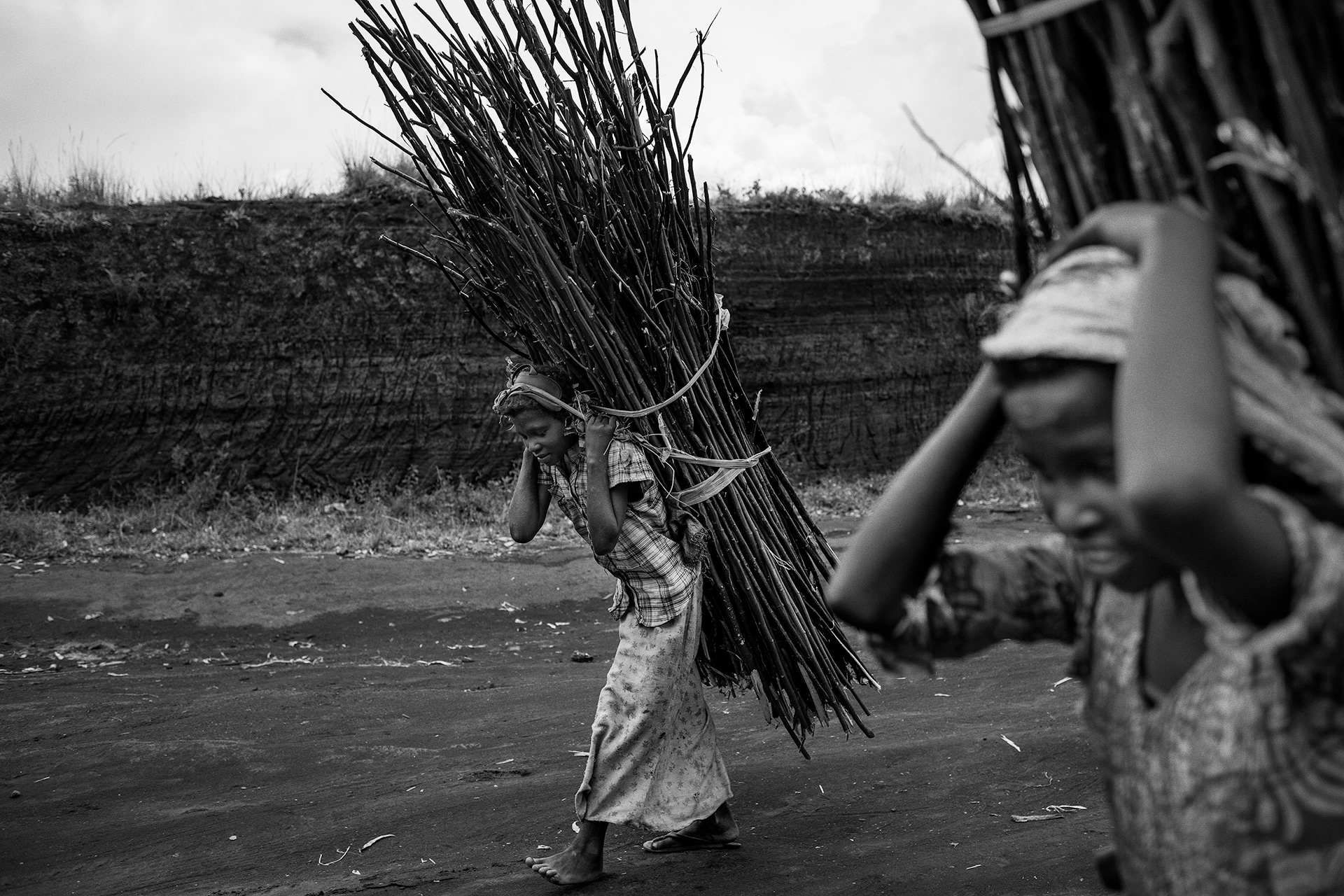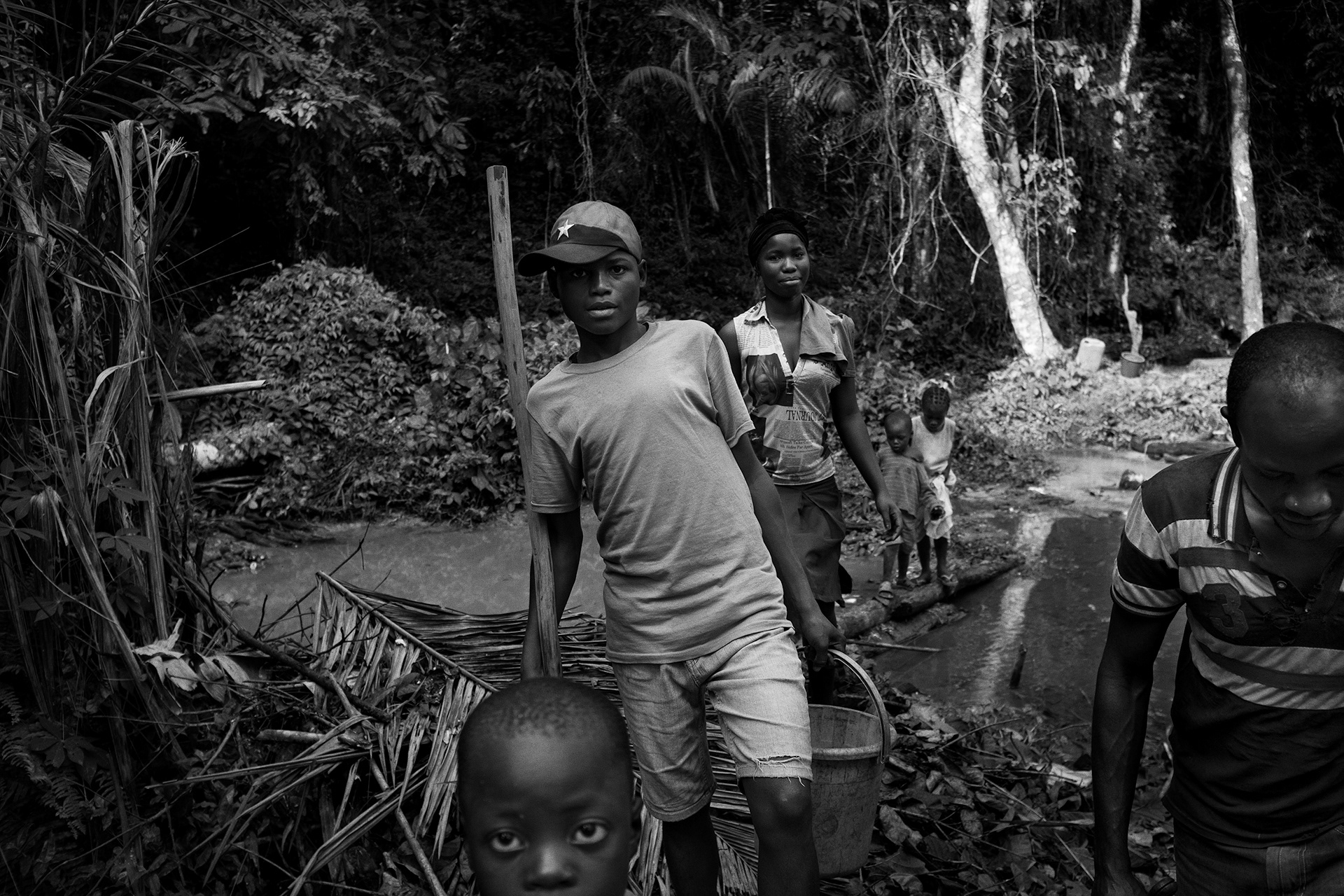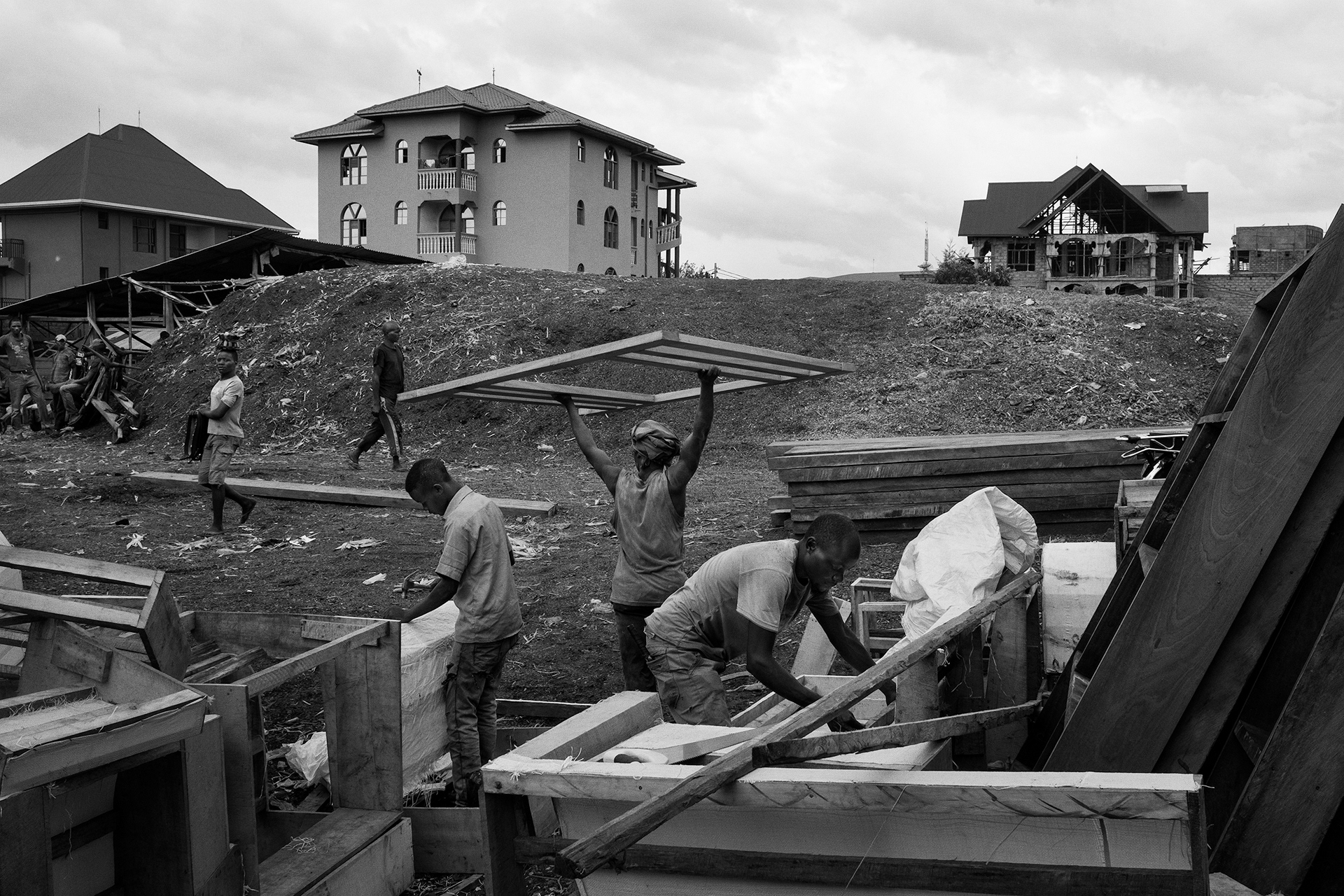Primary forests of the Dr-Congo appear unfathomable, immutable, endless. Though, in a country plagued with turmoil, firewood consumption, industrial exploitation and slash-and-burn agriculture jeopardize this resource. At the crossroad between the good will of environmental protection organizations and a population craving for wealth and local development lie the fate of these forests.
Kotya Libaya is a multimedia documentary project chronicling threats on the world’s second most important carbon sink.

South-Kivu, February 2016. Aerial view of woodlands clear-cut for agriculture needs. A major demographic growth in the country leads to an ever-increasing demand for arable land and firewood, at the expense of the forests neighboring populated areas.

Kanyanja, North-Kivu, March 2016. Yoshuera Kajeri is seen on a makala (the name in Swahili for charcoal) oven, used to char wood. With an electrification rate of only 10% charcoal remains the main source of domestic energy.

Kanyanja, North-Kivu, March 2016. From l. to r., Nyirakanya, Irature, and Neema pick up makala after it was charred in an oven. The combustible will be sold on the market of the provincial capital Goma. 97% of the households in this/the city use makala for domestic use, and only 20% of it comes from plantations like the one pictured. Most of it is charred illegally in the forests of the Virunga National Park, one of the last homes for mountain gorillas. The Park already lost about 20% of its vegetal cover.

North-Kivu, November 2016. Park rangers from the Congolese Institute for Nature Conservation (ICCN) inspect a truck loaded with bags of makala nearby the Virunga National Park. While ICCN tries to halt illegal charcoal production in the park, it remains among the top economic sectors in the area and is used as revenue by armed groups to fuel local conflicts.

ac Vert, North-Kivu, November 2016. Young women carry firewood, an activity often done by children or women. It is used by a part of the population too poor to buy charcoal, yet less harmful for health.

Mulongo, Katanga, September 2015. Women trade charcoal and firewood on a market in the rural town of Mulongo. As a consequence of the absence of electricity in this area, locals mostly rely on charcoal for their domestic energy.

South-Kivu, March 2016. Advertisement board for a reforestation project funded by the GIZ (the German international cooperation agency) on a landscape that was, before the sixties, fully covered with forests. Conflicts in this region neighboring Rwanda and Burundi led to massive displacements of population, which rely on wood for construction and domestic use. Now, severe landslides often hit this area where large portions of hills are clear-cut.

Kipushi Territory, Haut Katanga, October 2016. A woman plows her field with a hoe. Because of a lack of investment in the sector, agriculture –the main activity for 70% of the population- remains widely artisanal and of subsistence. Despite having more than 200 millions acres of arable land and two agricultural seasons, DRC remains one of the countries most affected by hunger in the world. Today, nearly 40% of children suffer from malnutrition.

Tshopo, July 2016. Traditional agriculture in woodland. In the DR-Congo, the average income per capita is 1.1$/day, and rural communities use slash-and-burn to clear forests and fertilize fields cultivated for subsistence. This method quickly degrades soils and farmers have to relocate their fields every 2 or 3 years, worsening pressure on the forest.

Ibi Village, Kinshasa Province, June 2016. A machete in a field. Because of poverty, many Congolese only have their machete as a tool, and use it both to work the soils and to gather firewood.

Monkoto, Tshuapa, October 2016. Youths in a model farm set up by the WWF to guide local farmers towards sustainable methods in a town neighboring Salonga National Park, the biggest woodland reserve in Africa. Bushmeat consumption and poaching are widespread among the local population, particularly youths who suffer from massive unemployment. The park administration tries to restrain these activities and to provide alternatives such as fisheries and farming, which are less destructive to the environment and settle inhabitants.

Kinshasa Province, June 2016. John, a farmer from a hamlet on the edge of Ibi village territory. In Ibi, the NGO GI Agro teaches environmentally friendly agroforestry techniques to the 1200 inhabitants of the ten neighboring hamlets.

Kipushi territory, Haut-Katanga, October 2016. Meeting of a farmers' association from the AFODEK agroforestry project. Funded by the EU, this project intends to increase the value of a degraded wooded savannah, by planting acacias (for charcoal production) alongside subsistence crops. One hundred and fifty families of farmers were selected and offered 12ha of land. The families committed to planting 1ha each year, a heavy workload in the absence of mechanical tools.

Mimbulu, Haut-Katanga, October 2016. King Kaponda, a traditional chief whose kingdom stretches between Haut-Katanga in DR-Congo and Zambia, on the occasion of the ceremony "Mutomboko Wa Bamfumu Kaponda Mwaiseni". The festivities celebrate the 26th anniversary of King Kaponda’s reign and the new agricultural year. Customs want the "King" to be the main decision maker on its territory but in practice, an unclear Congolese land law and a lack of security on the land prevents any projection for his community, leading to unsustainable agricultural practices. In an effort to settle households, the King has allocated 2,400 ha of rural land from his kingdom to the AFODEK agroforestry project.

Ubundu, Tshopo, July 2016. View from the provincial Environment Agency office of Ubundu. A lack of human and financial capacities restrains the local administration in enforcing the law and traveling on the ground to witness eventual abuses in the wood exploitation, or to record the many infractions that are committed.

Salonga National Park, Tshuapa, October 2016. A joint patrol of the Congolese Institute for Nature Conservation (ICCN) and DR-Congo Armed Forces (FARDC) in the Salonga National Park during an anti-poaching operation. The arrival of poachers armed with heavy weapons in the seventies led to a particularly brutal elephant slaughter episode. To secure and stop environmental crimes in this jungle bigger than Belgium, home of the bonobos and forest elephants, the ICCN sought help from the army.

Thsuapa, October 2016. Women on their way to a market in the neighboring town to sell their "chikwangue" (a traditional meal made of cassava) and other forest goods. Local populations rely mostly on the forests for their subsistence. There, they gather various medicinal, alimentary or energy-related products all year-round.

Tshopo, July 2016. A temporary bridge made by locals on the main road towards the forested area of Ubundu. In June 2016, the bridge collapsed under the weight of a truck, isolating all populations upstream and blocking the transfer of logistics for the forestry companies.

Babusoko, Tshopo, July 2016. Meeting of the local management committee of Babusoko, chaired by Albert Ngwanda Mokona Kabo (c.). The committee is in charge of the connection between the local population and the forestry company, legally bound to help develop the communities where it operates. In Babusoko, inhabitants recently blocked logs evacuation over a social clauses dispute. According to the local population, the company did not fulfill its obligations towards the community and logged more wood than agreed.

Babusoko, Tshopo, July 2016. Logs ready to be evacuated on the side of a road. When disputes arise between forestry companies and local communities (often over social clause fulfillment), the latter block wood logs to freeze the companies’ activity and pressure it. Incidents such as riots, property damage and community members shot dead were reported in several places of the country in the last years.

Tshopo, July 2016. An inhabitant of a forested area on his way home after a hunt. Bushmeat consumption is part of the local alimentary customs and communities often complain about animal scarcity induced, to them, by logging activities. Companies answer that bushmeat overconsumption by the growing communities is responsible for the “silent forest syndrome” (i.e. empty of all animals).

Babiondo, Tshopo, July 2016. Logging site in a forestry concession of the Bego-Congo company.

Goma, North-Kivu, March 2016. A carpentry workshop in the main sawmill of Goma. Here, school banks, sofas or house wood frames are manufactured to meet the demand of the provincial capital, unceasingly expanding for several decades. Traceability of the wood is not taken into account as on much of the internal market.

Kinkole, Kinshasa province, June 2016. A towboat with barges loaded with logs and passengers. Local populations often use these boats to travel and do business. The Congo river is the main way to transport wood produced in the DRC to the harbor of Kinkole, the biggest wood market of the country. Some logs travel up to 1,200km on the river, the only communication axis to cross the DRC.










